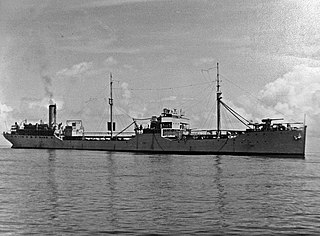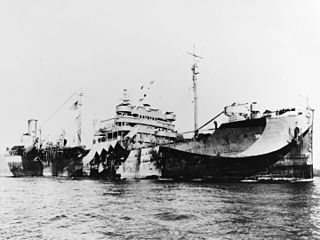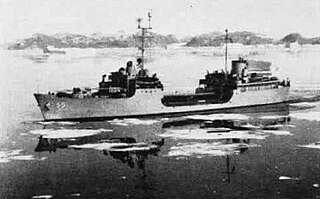
USS Patoka (AO–9/AV–6/AG–125) was a replenishment oiler made famous as a tender for the airships Shenandoah (ZR-1), Los Angeles (ZR-3) and Akron (ZRS-4). It was also notable in that its height figured prominently in the design of the Rainbow Bridge in Texas.

The second USS Maumee (AO-2) was laid down as Fuel Ship No. 14 on 23 July 1914 by Navy Shipyard, Mare Island, Calif.; launched 17 April 1915; sponsored by Miss Janet Crose; and commissioned 20 October 1916, Lt. Comdr. Henry C. Dinger in command. When the Navy's ship classifications were introduced 17 July 1920, Maumee was designated AO-2.

USS Sapelo (AO-11) was a Patoka-class fleet replenishment oiler of the United States Navy. Laid down on 3 May 1919 for the United States Shipping Board by the Newport News Shipbuilding and Dry Dock Co., Newport News, Virginia, the ship was launched on 24 December 1919, transferred to the Navy on 30 January 1920, and commissioned on 19 February 1920.

USS Kaweah (AO-15) was the lead ship of her class of fleet replenishment oilers in the United States Navy.

USS Mattole (AO‑17) was a Kaweah-class fleet replenishment oiler in the United States Navy.

USS Rapidan (AO-18), was a US Navy tanker of World War II.

USS Salinas (AO-19), a United States Navy Patoka-class replenishment oiler, was laid down for the United States Shipping Board (USSB) as Hudsonian (219592) on 10 April 1919 by the Newport News Shipbuilding and Dry Dock Co., Newport News, Virginia; launched on 5 May 1920; accepted by the USSB on 13 May 1920; transferred to the Navy on 29 October 1921; renamed Salinas and designated AO-19 on 3 November 1921; and commissioned at Mobile, Ala., on 16 December 1921.

USS Noxubee (AOG-56) was a Patapsco-class gasoline tanker acquired by the U.S. Navy for the task of transporting gasoline to warships in the fleet, and to remote Navy stations. She served in a commissioned status from 1945 to 1959, and 1965–1975. She was named for a river in Mississippi.

USS Whitley (AKA-91) was an Andromeda-class attack cargo ship in service with the United States Navy from 1944 to 1955. In 1962, she was transferred to Italy were she served as Etna (L9870) until she was scrapped in 1979.

The second USS Winooski (AO-38) was a Kennebec-class oiler in the United States Navy.

The second USS Monongahela (AO-42) was a Kennebec-class oiler in the United States Navy which saw service during World War II and the Korean War. She was the second U.S. Navy ship named for the Monongahela River in West Virginia and Pennsylvania.

USS Tallulah (AO-50), originally named the SS Valley Forge, was a Type T2-SE-A1 Suamico-class fleet oiler of the United States Navy.

USS Elokomin (AO-55) was a Cimarron-class fleet oiler acquired by the U.S. Navy during World War II. She served her country primarily in the Atlantic Ocean, Mediterranean Sea, and the North Atlantic Ocean Theatre of Operations, and provided petroleum products where needed to combat ships.

USS Housatonic (AO-35) was a Chicopee-class oiler acquired by the United States Navy for use during World War II. She was the third ship of the U.S. Navy named for the Housatonic River in Massachusetts and Connecticut.

USS Aucilla (AO-56) was a Cimarron-class fleet oiler. She was constructed for the United States Navy during World War II and her assignment was to provide liquids, such as fuel or water, to ships in the forward battle areas. She survived this dangerous task and returned home post-war with five battle stars to her credit.

USS Chiwawa (AO-68) is a former T3-S-A1 Kennebec-class oiler constructed for the United States Navy during World War II. She was the only U.S. Navy ship named for the Chiwawa River in Washington.

USS Enoree (AO-69) was a Chiwawa-class oiler constructed for the United States Navy during World War II. She was the only U.S. Navy ship named for the Enoree River in South Carolina.

USS Escalante (AO-70) was a T3 Kennebec-class oiler built for the United States Navy during World War II. She was the only U.S. Navy ship named for the Escalante River in Utah.
USS Kalamazoo (AOG-30) was a T1-M-A2 Mettawee-class gasoline tanker acquired by the U.S. Navy for the dangerous task of transporting gasoline to warships in the fleet, and to remote Navy stations.

USS Nespelen (AOG-55) was a Patapsco-class gasoline tanker in the service of the United States Navy.



















